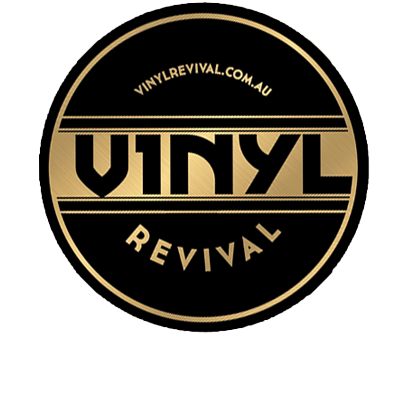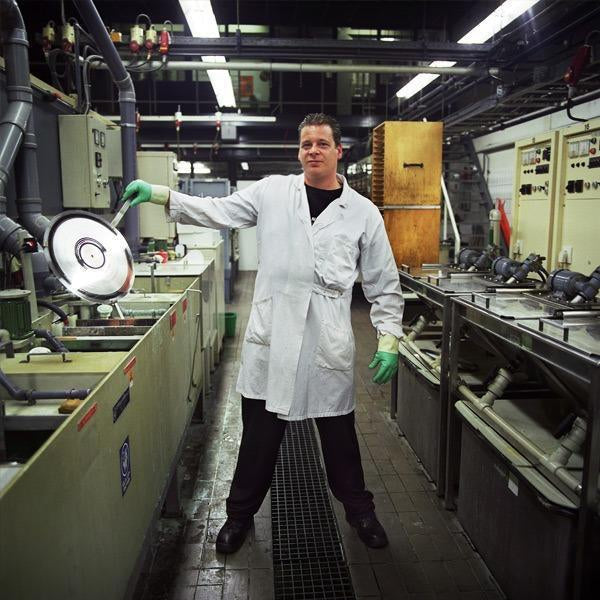With the current constant upward trend in record sales the established record pressing plants are being kept very busy. There are also new pressing plants being set up around the world to keep up with demand.

In 1877,Thomas Edison was credited with inventing the phonograph,the first device to both record and playback sounds. It recorded sounds directly. It recorded music directly as indentations on a sheet of tin foil wrapped around a grooved cylinder, which would move the needle across the indentations, vibrate the mechanical diaphragm accordingly and reproduce the sound.
It wasn't until the early 20th century that the cylinder was replaced by the flat disc record we use today. But even then sounds were recorded directly, mechanically onto the disc. "Acoustical" recordings like this relied on a large horn to vibrate, so too did the stylus which transcribed the vibrations onto a hand-cranked wax disc. The result was a low-fidelity recording with low volume.
It wasn't until 1925 that the audio input was put through a mic and amp to boost the dynamic range and volume without relying on the physical attributes of a horn. These 78 rpm records were seen as a great technological leap over the hand-cranked predecessor.
The quality of recordings improved vastly in the 1950's with the introduction of 33 rpm records, which held about 25 minutes of music a side, and audio tape, which could be easily edited and it's sound optimised in post production then dubbed onto a master disc for reproduction. This master disc is known as an acetate or lacquer disc. Unlike mass produced vinyl recordings which are moulded, the master disc is physically cut, it's grooves gouged out by a record-cutting machine's needle whose mechanical motion is guided by an audio input. The grooves are routinely checked during the cutting process to ensure a proper depth of cut and to adjust volume and pitch on the playback. A metal cast is then made of the lacquer.
Originally, the lacquer was coated in an extremely fine layer of electrically-conductive graphite to which silver or nickel was then plated. Once the plate was thick enough, the wax was stripped away leaving a sturdier metal mould. Modern techniques involve dipping the disc into a solution of stannous chloride and then spraying on atomised silver. The conventional plating bath technique is also still widely used but is not as acoustically accurate.
After the initial silver plating has hardened a layer of fine-grained copper is applied, followed by a layer of more robust, coarse-grain metal like steel. Once enough metal has been applied to support the silver plate, the lacquer is smashed free of the mould, leaving the metal negative or "Matrix".

The Matrix is still pretty maleable so it must be recast once more before it can begin pressing vinyl. A metal record known as "The Mother" is cut from the Matrix and then repeated to create another negative known as the "Stamper". Since the Mother is cut from a metal such as copper it can withstand multiple recastings to churn out multitudes of stampers, which are then used to press the actual production records.
Each stamper, which is attached to an autonomous 100 tonne hydraulic press, works essentially like a waffle iron and can churn out 1,000's of records before needing replacement. A sheet of pre-heated vinyl roughly half the area but 3 times the thickness of a finished disc, known as the biscuit, is slipped between the jaws of the press. 300 degree steam is then applied to further soften the material before the jaws close and squeeze the hot vinyl into it's final shape while imprinting the audio. The disc is then cooled and hardened in a water bath and then labelled - all of which is done automatically.
Once it comes off the stamper, the record's edges are trimmed into a neat circle on an automatic trimmer table and the record is then inspected, both visually and audibly. Many presssings are faulty and are melted down to be restamped. The quality LP's are packaged and shipped.

The former EMI record pressing plant that is famous for pressing the Beatles records in the 1960's is now owned by a company called The Vinyl Factory. Established in 2001 The Vinyl Factory Group bought the old EMI manufacturing complex in Hayes which was being sold and the plant was scheduled to close. The manufacturing plant had been set up by EMI in the 1970's after moving from it's old plant, also in Hayes. The plant still presses 10,000 records a week. Some interesting points about the plant include the fact that the vinyl passes through the factory untouched by human hands (the vinyl comes straight out of the stamper and slides into the inner sleeve). Some of the machines are the ones installed by Roy Matthews when the factory opened and therefore would have pressed the original Dark Side Of The Moon. There is also no releasing agent used to get the pressed as albums from the stampers.

The Vinyl Factory Group encompasses a record label, the vinyl pressing plant, the record shop Phonica and music magazine FACT, in addition to all of it's visual arts commissions, exhibitions and collaborations between musicians and contemporary artists.
The Vinyl Factory record label releases limited editions made in collaboration with both artists and musicians. Releases to date include Massive Attack, Pet Shop Boys, Bryan Ferry, Florence And The Machine and many others. The Vinyl Factory now presses over 50% of the UK's vinyl.

North America's second biggest record processing plant has opened in Burlington, Canada. It is owned by the President of major music distributor Isotope Music, Gerry McGhee. In Phase 1 of production the plant can do 4.5 million records a year. In Phase 2, once additional presses are added, the plant should have a capacity of up to 11 million records a year which will make it the second largest plant in North America. Their delivery time on orders of 6-8 weeks is a game-changer for the industry.

What a lot of vinyl fans don't realise is that the resurrected vinyl plants and the few new ones that have been built are working 24/7 to keep up with the increasing demand that is the "vinyl revival". Music lovers of multiple generations are embracing the analogue format in a way not expected and creating a demand for vinyl and turntables that despite some saying it is a "fad" is actually a trend toward the atmospheric analogue experience and the tactile experience of owning the piece of music they love and going on the journey that the artist intended in their creation of an album.
Discover the atmospheric world that is the vinyl experience with our turntable range. It will truly take you to a special space. CLICK HERE


Share:
Cartridges: Where the magic begins
What is a Hi-Fi System: A Beginner's Guide